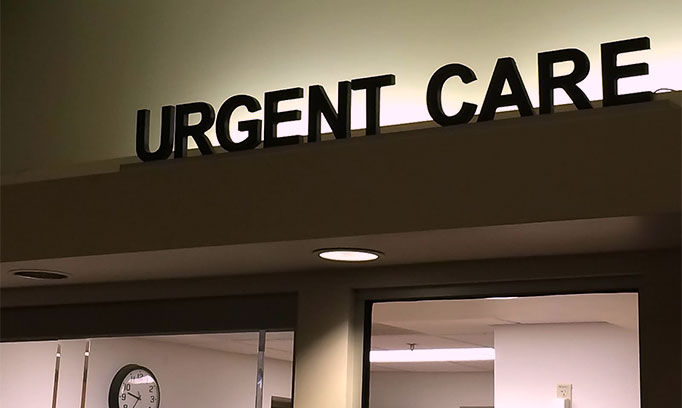What to Expect at a Leading Clinic Offering Urgent Care Services
What to Expect at a Leading Clinic Offering Urgent Care Services
Blog Article
Comprehending the Role of Urgent Treatment in Offering Timely Therapy for Non-Life-Threatening Conditions
Immediate treatment centers have emerged as an important element of the healthcare landscape, dealing with the immediate requirements of individuals with non-life-threatening conditions. Comprehending the subtleties of immediate care could substantially affect individual outcomes and the total effectiveness of medical care shipment.
What Is Urgent Care?
Urgent care refers to a classification of clinical services created to attend to non-life-threatening problems that require prompt interest. These facilities work as an intermediary in between medical care medical professionals and emergency spaces, offering a convenient choice for individuals that require prompt care without the substantial waiting times generally connected with emergency situation divisions.
Immediate treatment facilities are commonly staffed by medical professionals, including doctors, nurse professionals, and medical professional aides, that are educated to detect and deal with a vast array of conditions. Common services provided by these centers include treatment for minor injuries, illnesses, and infections, as well as diagnostic tests such as X-rays and laboratory work.
In addition, urgent treatment centers usually accept walk-in patients, removing the requirement for visits. Overall, immediate care plays an essential duty in the health care system, making certain clients can access essential clinical solutions promptly and effectively.

When to seek treatment at an urgent care center rather of a main treatment doctor or an emergency space,Many people may locate themselves unclear about. Immediate care is designed to address non-life-threatening conditions that call for timely interest however are not severe adequate to warrant an emergency room check out.
Normally, one need to take into consideration urgent look after issues such as small cracks, sprains, cuts calling for stitches, or infections like urinary system infections. In addition, chilly or influenza symptoms, rashes, and allergic responses can also be appropriately taken care of in this setting.
It is important to note that immediate care is not ideal for serious emergencies, such as breast discomfort, trouble breathing, or extreme bleeding, which necessitate instant emergency clinic treatment.
Individuals who lack access to a main care medical professional or can not safeguard a prompt appointment may also gain from urgent care services. Eventually, recognizing when to make use of immediate treatment can result in much more effective health care shipment, enabling individuals to get the proper level of care based on their specific health needs.
Advantages of Urgent Treatment Centers
Picking immediate care centers for non-life-threatening conditions offers several benefits that boost individual experience and availability. One main benefit is the decreased wait times compared to typical emergency situation areas. Urgent care centers generally operate on a first-come, first-served basis, allowing patients to obtain prompt medical attention without the lengthy hold-ups typically connected with medical facility settings.
In addition, immediate care facilities supply prolonged hours, including nights and weekend breaks, suiting clients with varying timetables. This versatility ensures that people can seek treatment when it is most hassle-free for them, additionally promoting prompt treatment.

Moreover, these centers commonly use a detailed range of solutions, consisting of minor treatments and analysis tests, all under one roof. This consolidation of solutions not only streamlines the person experience however also cultivates a more natural method to managing non-life-threatening wellness issues, inevitably anchor benefiting total client end results.
Typical Problems Treated
At urgent treatment centers, a range of non-life-threatening problems can be effectively treated, giving clients with obtainable and timely medical support. These centers are specifically proficient at attending to issues that require timely focus but do not position an instant threat to life or limb.
Typical conditions dealt with at immediate treatment centers include small injuries such as stress, sprains, and fractures. Furthermore, they take care of diseases like colds, influenza, and infections, including urinary tract infections and sinusitis. Skin disease, ranging from rashes to insect attacks, are additionally often addressed. Urgent treatment facilities are equipped to carry out essential analysis tests, such as X-rays and lab examinations, enabling them to supply detailed treatment.
Moreover, urgent treatment providers can carry out inoculations, helping to stop the spread of transmittable illness - Urgent Care. They also supply solutions for minor procedures, such as suturing injuries or draining abscesses. By supplying these diverse services, urgent treatment centers play a vital duty in connecting the void in between primary treatment and emergency services, making certain clients receive timely therapy for a large range of problems without the requirement for long haul times typically read related to emergency clinic
How Urgent Treatment Supports Medical Care System
Urgent treatment centers play a crucial function in sustaining the general medical care system by minimizing the burden on emergency situation divisions and supplying timely accessibility to medical treatment for non-life-threatening conditions. By dealing with instances such as minor injuries, infections, and illnesses, immediate treatment facilities allow emergency situation divisions to concentrate on more critical people calling for instant interest.
Furthermore, immediate treatment centers enhance health care access, offering prolonged hours and an extra hassle-free alternative to conventional medical care setups. This accessibility is particularly helpful for people that might not have a regular physician or who call for prompt therapy beyond typical office hours. Because of this, urgent care centers effectively decrease enhance and wait times client contentment.
In addition, immediate care facilities add to cost savings for both patients and the healthcare system by providing lower-cost services contrasted to emergency situation divisions. This financial efficiency is vital in a period of climbing medical care expenses, enabling clients to receive necessary treatment without sustaining excessively high expenditures.
Verdict
To conclude, urgent care facilities play a crucial function in the health care system by delivering punctual therapy for non-life-threatening conditions. By bridging the void between medical care and emergency clinic, these facilities make certain that individuals receive prompt clinical attention without the extensive wait times generally related to emergency situation departments. The ease of access and efficiency of immediate care centers add dramatically to easing the general burden on medical care resources, enhancing person end results, and promoting a more reliable medical care shipment system.
Immediate care facilities have arised as an important part of the health care landscape, resolving the instant demands of clients with non-life-threatening problems. Urgent treatment sees typically sustain lower out-of-pocket costs contrasted to emergency department brows through, making care a lot more budget friendly for clients without endangering quality. Urgent treatment facilities are equipped to do essential diagnostic tests, such as X-rays and lab examinations, enabling them to offer detailed treatment.
By offering these diverse services, immediate treatment facilities play a vital function in connecting the void in between primary care and emergency solutions, making sure patients receive timely treatment for a large array of problems Learn More without the need for long delay times normally linked with emergency rooms.
Furthermore, urgent care centers enhance health care availability, using prolonged hours and a more convenient alternative to conventional primary care settings.
Report this page